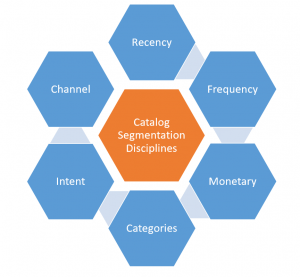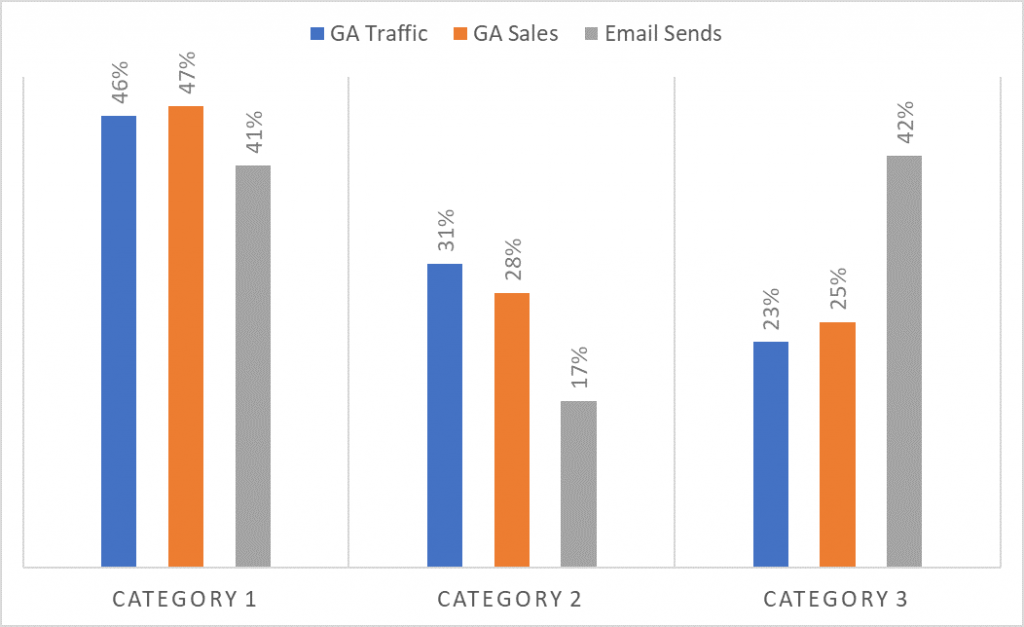This year at our annual Integrated Marketing Summit, I taught a workshop discussing the ways retailers should incorporate segmentation to boost topline sales and increase bottom-line profits. Segmentation and relevancy would also help to counteract the continued decline in open and click-through rates as indicated in our annual benchmark report below.

As the volume of emails continues to rise year over year, key customer conversions percentages continue to suffer as a result, but revenue continues to climb.

The paradox of email marketing is that by adopting a “one-size-fits-all” approach of sending mass emails typically results in a “one-size-fits-none” outcome, despite revenue remaining strong. I would argue that brand engagement (and enjoyment), even though stable, will continue to decline without segmentation and personalization. The average person receives approximately 75 emails each day with competition in the inbox. It’s no longer enough to send emails for the sole purpose of keeping in touch. While it is essential to keep the broader organization in mind, maintaining a laser focus at the individual customer level is foundational for success. By the way, maintaining this relentless focus on the individual customer level is vital for your other marketing channels, too.
Is Email Marketing Really Evolving?
At this year’s Summit, Ross Kramer, the CEO of Listrak, discussed four key levels that retailers will fall into (see below). While email volume has exploded over the last decade, sadly the evolution of email strategies and tactics have not. According to Ross, nearly 80% of retailers are stuck at level 1 with few retailers graduating to Level 2 or above. In this article, we will discuss the importance of segmentation strategies to move your brand into Level 2.

All About the Data
As direct marketers know, data is our lifeline! And this is where tried and true direct marketing programs can be invaluable for any email marketing program. In our world, segmentation and relevancy increase engagement metrics, decrease fatigue, and thereby improve ROI. Recency, frequency, and monetary (RFM) values are still the ideal way to understand customer behavior, and remain today the most frequently adopted segmentation techniques in direct marketing.
Amongst the three RFM measurements, recency is the most important. Frequency and monetary could be considered as functions of each other by adding a secondary and tertiary dimension to rank customer behavior.
The simple hypothesis of this approach is that people who most recently and frequently engage with your business will be the most likely to buy again (have not churned) from your business.
The first and most crucial segmentation change we recommend is to separate buyers from subscribers in your email file. Buyers will outperform non-buyers between 6x to 10x depending on the vertical. As such, your email cadence and promotional strategy should be dramatically different for these two groups. Buyers buy, subscribers surf!
As your file grows, there will be other selection variables: how frequently a customer purchases, merchandise categories, their Average Order Value (AOV), channel of acquistion. Classify both buyers and subscribers by email activity behavior and other criteria that may be important indicators of conversion for your marketing efforts.
The more you can segment, the better you can target specific marketing campaigns around the segments that will perform well to more content-based (or more emails) and those who might only respond to promotional emails (one-time buyers or non-buyers) with less annual sends. Advanced segmentation is routine in direct mail, and it should be in the email channel as well. At a minimum, you can make a dramatic difference by merely creating a buyer vs. non-buyer segment group.
Case Study
During my stint as the Senior Director of Marketing at NapaStyle, it was clear that changes to email segmentation must be made to more closely mirror segmentation on the print marketing efforts. Inherently, I knew that buyers would perform better than subscribers and it didn’t make sense that we were emailing everyone for every email campaign. In the year before our segmentation changes, we mailed over 34mm records that performed well, but I knew we could do even better.

After sitting down with the head merchant, we added three key merchandise/buyer segments:
- Cross Over Buyers: customers who purchased in both home and entertainment categories.
- Home Buyer: customers who only purchased from the home categories / SKUs.
- Entertainment: customers who only purchased from the entertainment categories / SKUs.
- Subscribers: never made a purchase.
The changes made allowed us to mail to our best customers more often with relevant content, and reduce the number of emails to prospects (subscribers) who were unlikely to purchase without a promotion to incentivize a purchase. The net effect is that we were able to reduce our sends by 7% (cost savings of $80k) while driving 17% more demand.

Aligning Marketing Efforts Around Segmentation and Content
Years of working with marketing teams have taught me that roles and responsibilities aren’t always as clear as you’d like them to be. When misalignment exists, proper content and strategies become ineffective and thereby reduces demand. As per the example below, we analyzed performance for a retailer that had three distinct business classifications that we will name as Category 1, Category 2 and Category 3. In reviewing customer insights and how email volume corresponded with customer behavior/sales, we came across a few surprises.

For Category 1, email volume closely matched online customer behavior. Meaning, the number and volume of email sends corresponded with the percentage of sales and traffic this category drove online. However, in Category 2 and 3, there was a misalignment of marketing efforts relating to customer sales and traffic. While Category 2 drove 31% of traffic and generated 28% of demand, emails sent annually only represented 17% of marketing activity. Clearly, not enough push emails were delivered to this customer group. Conversely, Category 3 only represented 23% of traffic volume and 25% of sales, yet email volume represented 42% of the marketing efforts.
Internal teams can’t align if they don’t work together and this example undoubtedly articulates the need to align merchandising teams with marketing teams better. Begin helping your business teams work as one larger unit by encouraging them to be open and transparent about what factors are driving sales, and mirroring those efforts around customer contacts and relevancy. Department leaders and teams should meet regularly to track shared goals and communicate freely about workflow, obstacles, and wins.
While email is relatively cheap, it can strain personnel and production resources and can be tedious to develop email campaign after email campaign incessantly. Therefore, following email best practices can be tiresome and challenging to do at times. Nevertheless, taking the easy way out in email marketing will inevitably lead to less success in your campaigns.
Segmentation and relevancy in your email marketing will boost your email marketing engagement by providing content that is more relevant to your email segments. These moves will position you for more success in an ever-changing market.
I would be happy to discuss your email programs, just email me at mhouston@cohereone.com
